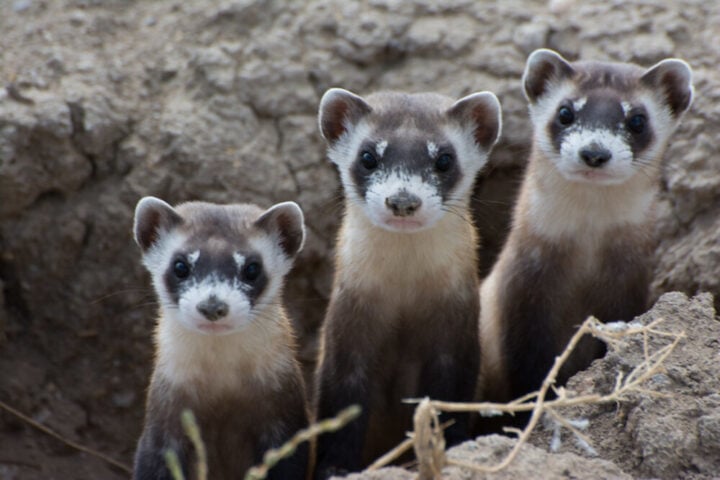On Monday, the small Alaskan community of Utqiaġvik, located 320 miles north of the Arctic circle, finally saw the sun again after 65 days of darkness. Despite the brief glimpse, with the sun rising at 1:03 p.m. and setting at 2:15 p.m., the residents of Utqiaġvik were overjoyed to see the sun again after the last one was seen on November 18, 2022.
Photographer Mark Mahaney traveled to the northernmost town in the U.S. to document the first sunrise of the year and to hear from the residents, police and Iñupiat Alaskan Natives about what it’s like to live in the dark. He described the town during the winter as an “energetically heavy place.”
“It was a very intense place to be during that time of year in the town. The crime spikes, different abuse goes up,” said Mahaney. “The local police department gets random calls from citizens saying that they feel disoriented, that they don’t know what time of day it is, or they don’t know the day of the week it is.”
As the days progress, the residents of Utqiaġvik will have the opportunity to experience an increasing amount of sunlight. In the coming days, the town will see an additional 25 minutes of sun each day. By the time February rolls around, residents can expect to see an extra 10 minutes of daylight each day. As we move into mid-March, the town will be bathed in sunlight for 12 hours a day. Even on March 23rd, when the sun dips below the horizon, the town will remain in a state of twilight throughout the entire night.
The residents of Utqiagvik, also known as Barrow, will have to wait until April 23rd for complete darkness again. However, starting May 12th, 2023 the town will be bathed in the light of the midnight sun, with the sun remaining visible until August 2nd. Despite the sun being below the horizon during winter, the low angle of the sun ensures that the town is enveloped in a perpetual state of twilight.

Utqiaġvik Residents Welcome the Sun After 65 Days of Darkness
Latest from Nature

Four Spider Species Found in Northeast India; Half New for Nation’s Records
Scientists from the Zoological Survey of India (ZSI) have uncovered four significant spider species in Northeast India, revealing the rich biodiversity that remains largely unexplored in the region. The discoveries include two

Auckland Zoo welcomes forester kangaroos from Australia before Anzac Day
A mob of forester kangaroos has arrived at Auckland Zoo, bringing a touch of Australia to New Zealand just before Anzac Day. The kangaroos, a subspecies of the eastern grey kangaroo, have

Emu Chick Hatches at Longleat After Father Sits 56 Days, Expected to Reach 1.5 Meters
An emu chick has hatched at Longleat Safari Park just in time for the Easter weekend, marking only the second offspring for resident emu pair Bounty and Biscuit. The chick emerged from

Migratory Bird Treaty Act Rollback Ends Penalties for 1 Billion Industrial Bird Deaths Yearly
The U.S. Department of the Interior has reinstated a controversial interpretation of the Migratory Bird Treaty Act (MBTA) that removes protections for birds killed accidentally by industrial activities. The April 11 decision
New York Endangered Species List Updated After 26 Years With 3 Amphibians Added Following 1,300 Comments
New York State has finally updated its endangered species list after a 26-year gap, adding the Atlantic Coast Leopard Frog, Eastern Tiger Salamander, and Eastern Fence Lizard to its protected lists. The

Crater Lake Newt Drops to 13 as Crayfish Take 95% Shoreline, Lawsuit Targets ESA Delay
The Center for Biological Diversity has announced legal action against the Trump administration over the U.S. Fish and Wildlife Service’s failure to protect the Crater Lake newt under the Endangered Species Act.

Gray Whales Suffer 94 Deaths in Baja Lagoons, Calf Pairs at Record‑Low Eight
Something concerning is happening to the gray whales that make their yearly journey along California’s coast. After showing some recovery from a 2018-2023 “unusual mortality event” (UME), these marine giants are dying

The Antler Chronicles: Wyoming’s Shed Hunt Evolution
Categories: Nature, wildlife External link: Shed hunting season has arrived for some parts of the state | Wyoming Game & Fish Department Wyoming shed antler hunters support regulations, survey says | Local

Colchester Zoo Sea Lion Atlanta Dies Suddenly After 21 Years—What Vets Couldn’t Confirm
Colchester Zoo is grieving the loss of Atlanta, a much-loved Patagonian sea lion who died on Sunday, April 13, 2025. The sea lion passed away in the early morning hours after her

Google DolphinGemma AI Uses 400M Parameters To Analyze Dolphin Sounds On Pixel 9
Google has launched DolphinGemma, a new AI model that listens to dolphin sounds and tries to make sense of them. This joint effort by Google, the Wild Dolphin Project, and Georgia Tech

Brook Floater Mussel Faces 95% Decline as Lawsuit Revives 15-Year Fight for Endangered Species Protection
Environmental groups led by the Center for Biological Diversity filed a lawsuit on April 17, 2025, to push the U.S. Fish and Wildlife Service to protect the brook floater mussel under the

Endangered Species Act Redefinition May Strip Legal Habitat Protections Nationwide
The Trump administration has proposed a significant change to the Endangered Species Act (ESA) that could dramatically reduce protections for wildlife habitats across the United States. The proposal, announced on April 16,

Johnston Atoll Rocket Pads Threaten 1.5M Seabirds and U.S. Wildlife Refuge Recovery
When rockets meet rookeries, who prevails? Johnston Atoll—a remote Pacific wildlife refuge harboring 1.5 million seabirds—faces an existential quandary as the U.S. Air Force advances plans to transform part of this ecological

Chimpanzee Transfer Ends as 23 Research Chimps Relocate from Alamogordo Lab to Louisiana Sanctuary
The final cohort of Pan troglodytes from the Alamogordo Primate Facility in New Mexico has completed their translocation to Chimp Haven, the federal chimpanzee sanctuary in Louisiana. This ex-situ conservation effort closes

World’s Largest Chimpanzee Sanctuary Is a 200-Acre Louisiana Haven for Over 300 Former Research Chimps
Twenty-one chimpanzees have just started their retirement at Chimp Haven, marking the end of an era in American medical research. These chimps, who spent decades helping scientists develop life-saving vaccines and medicines,


